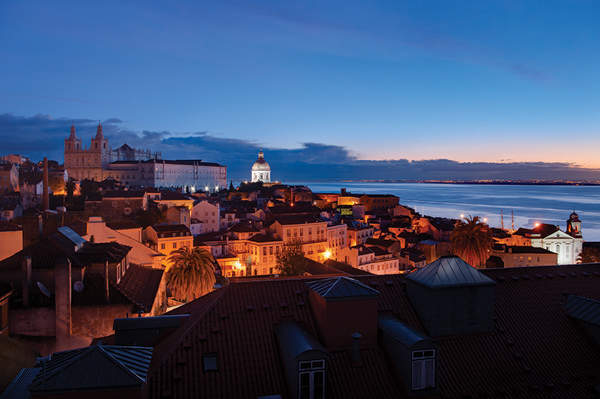

Hotels love to declare their uniqueness. A fawning manager will go out of his way to embellish their privacy, suggesting that only those in the know are privy to their existence. Which is total nonsense. Hotels survive through word of mouth, marketing and reviews such as this.
But every so often there is one such property that achieves the aspired-to levels of elusiveness and Lisbon’s Palacio Belmonte did so with aplomb. So much so that we looked for the entrance for twenty minutes while standing outside it, arrogantly assumed we were the only guests staying, and heard nothing but guitar music from the cobbled streets below – despite all ten suites being occupied.
But we were lucky with the Padre Himalaya suite. Housed in the top of a Roman tower, the three-level honeymoon suite has a 360-degree view over Lisbon’s Alfama district. Throwing open the wooden shutters, guests can gaze over terracotta rooftops jostling for position on the slopes of the old town, and the river Tagus shifting and twinkling in the sun.
A carefully planned and eco-friendly ventilation system means there is no need for air-conditioning as fresh air weaves around the room batting at the white linen drapes veiling the bed. It’s a writer’s paradise: there’s nothing but a grand old birdcage, a writing desk with fresh rosemary in a vase and a tiled floor begging for bare feet. There is intermittent wifi for the obstinate but this is no place for computers and iPhones and you won’t find a TV. This is for books, naps and lolling around in cotton dresses.

Wind down the stone staircases, ducking your head, and you’ll come to the library where there are sunken sofas, antique chessboards and a cupboard that creaks open to reveal an honesty bar of vintage port. It feels like wandering through a noble’s home while they’re on holiday and I half expected to see a group of rucksack-wearing tourists on a guided tour considering the palace’s history.
It was once the residence of the Marques de Atalaya, Pedro Álvares Cabral, and the earls of Belmonte, the first section of which was built in 1449, its towers dating as far back as 123BC. Somehow the palace survived the 1775 earthquake and it still contains carved Visigoth pillars and seventh-century Moorish brick ceilings.
Guests are given a single large gold key to enter the front door, a beautiful wooden salsa-red door betraying nothing about the hotel within. And it was with the greatest of smugness that we appeared in the morning to find tourists lurking in the courtyard gazing at the façade. We slipped the key in the lock and swaggered off, only to be stopped short by a huge mural on the hotel’s exterior with the words ‘Don’t Be Mean’.
The hotel’s a five-minute walk to local restaurants pumping out the smell of grilled sardines, but if you want to keep your stay as private as possible, then ask for Michelin-starred chef José Avillez to cater to your needs on the moonlit terrace and gaze over the city as though it were your own.







